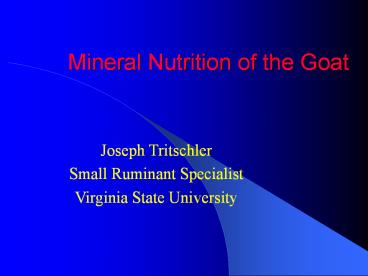Mineral Nutrition of the Goat - PowerPoint PPT Presentation
Title:
Mineral Nutrition of the Goat
Description:
... Selenium Trace minerals most commonly deficient Often deficient in same location Areas include eastern U.S. Molybdenum increases copper requirement One ... – PowerPoint PPT presentation
Number of Views:322
Avg rating:3.0/5.0
Title: Mineral Nutrition of the Goat
1
Mineral Nutrition of the Goat
- Joseph Tritschler
- Small Ruminant Specialist
- Virginia State University
2
Nutrients necessary for ruminant animals
- Water
- Energy (carbohydrate, protein, fat)
- Protein (amino acids)
- Minerals (salt, macrominerals and trace)
- Vitamins (A, D, E, K but not Bs or C)
- (Fiber for GI function)
- (Essential Fatty Acids)
3
Essential Minerals of Animals
- Macrominerals
- Salt (NaCl)
- Calcium (Ca)
- Phosphorous (P)
- Magnesium (Mg)
- Potassium (K)
- Sulfur (S)
- Microminerals
- Iron (Fe)
- Iodine (I)
- Copper (Cu)
- Molybdenum (Mo)
- Cobalt (Co)
- Manganese (Mn)
- Selenium (Se)
- Fluorine (F)
4
Macromineral Requirements(percent diet DM)
5
Sodium and Salt Deficiency
- Salt (sodium) always inadequate in forages
- Sodium requirement higher than chlorine
- Low salt decreases growth
- Inappetence
- Salt intake data (sheep)
- 0.5 salt in total mixed rations (0.2 Na)
- 1.0 or more in concentrate supplements
- Free choice lambs eat 5 10 g/d ewes eat 15
30 g/d - Range ewes eat less in salt licks
6
Calcium and Phosphorous
- Critical for milk production bone growth
- Calcium deficient in concentrate feeds
- Rapid need for Ca in lactation
- Inability to mobilize Ca leads to milk fever
- Legumes lined pastures good Ca sources
- Phosphorous deficient in forages
- Very widespread mineral shortage
- Poor growth, lower reproductive performance
7
Calcium Phosphorous Ratio
- Calcium to phosphorous best in a ratio
- Absorbed and mobilized together
- Ideal ration 1.51 to 21 (CaP) (can be higher)
- Urinary calculi in breeding male goats
- Observed with high phosphorous
- Observed with low CaP ratios
- Usually breeding males in confinement
- Related to low potassium and magnesium levels
- Ration additives are available (KCl, NH3Cl)
8
Magnesium and Grass Tetany
- Physiologically a Mg deficiency
- Occurs under periods of stress
- Lactating cows starting spring grazing
- Does (and ewes) not as problematic as cows?
- Associated with excess N K fertilization
- Form insoluble Mg complex in rumen
- Forage analysis may indicate adequate Mg
- Use ratio of K / (Ca Mg) (below 2.3
milliequivalents) - Mg generally lower in cool-season grasses at
lower temp. - Best prevented through management
- Stress reduction (overworking animals)
- Mg fortified supplements in the critical period
(spring) - Dolomitic limestone contains both Ca Mg
9
Potassium and Sulfur
- Not commonly deficient
- Potassium possible low in concentrates
- Sulfur possibly low in highly leached soils
- High K ( N) fertilization
- Increased grass tetany problems
10
Lime, Fertilizer, Cost and Environmental Health
- Limestone (Ca and Mg (dolomite))
- Reduces soil acidity (needed for legumes)
- Usually more limiting than fertilizer
- Fertilizer (N, P and K manure also)
- Essential for plant growth
- N and P excess are environmental problems
- N and P are relatively expensive
- Fertilizer, Manure Minerals
- Regulations to control environmental (water)
quality
11
Micromineral Requirements(ppm or mg/kg diet DM)
12
Copper, Cobalt, Selenium
- Trace minerals most commonly deficient
- Often deficient in same location
- Areas include eastern U.S.
- Molybdenum increases copper requirement
- One negative aspect of liming
- Copper and selenium potential toxicities
- Deficiencies are more common
13
Micromineral Tolerances (ppm or mg/kg diet DM)
14
Copper Sheep and Goats
- Copper requirements are the same
- Cattle, sheep and goats
- Requirement about 10 ppm
- Copper tolerance lower is sheep
- All ruminants have relatively low tolerance
- Sheep tolerate 25 ppm
- Cattle tolerate 100 ppm
- Goats tolerate at least 40 ppm
15
Mineral Summary
- Goat requirements
- Relatively little research
- Requirements extrapolated for cattle sheep
- Relative susceptibility to nutritional disorders
- Milk Fever dairy cattle than dairy goats
- Grass Tetany beef cattle than sheep
- Pregnancy Toxemia sheep and goats
- Copper Toxicity sheep than goats and cattle
- Overeating Disease lambs and kids
- Toxicities seem to be less in goats (metabolism)
16
Mineral Summary
- Cattle sheep supplements work for goats
- Salt (free choice) is necessary
- Phosphorous low in forages
- Calcium low in concentrates
- CaP ratio ideally 1.51 to 21
- High Mg supplement in early lactation
- Cu, Se, Co in trace minerals































